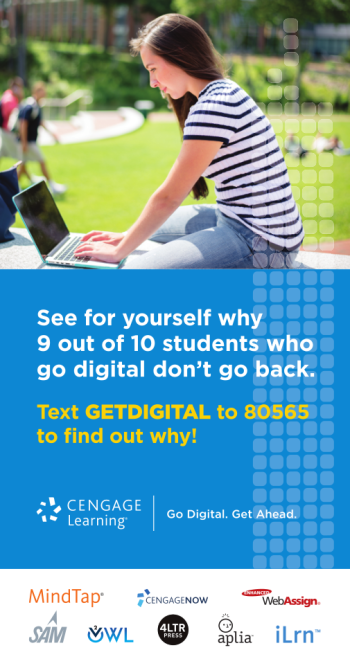You have /5 articles left.
Sign up for a free account or log in.

An example of a campus flyer
Cengage
Don’t be surprised if major publishers show up on campus this fall. In an effort to increase awareness -- and sales -- of digital course materials, publishers are pitching and selling their products directly to students.
The ongoing transition from print to digital in the textbook world is providing publishers an opportunity to learn more about students as consumers and, over time, gain greater control of how course materials are sold, analysts say. Several of the major textbook publishers, Cengage Learning and McGraw-Hill Education among them, have already begun that process by expanding the scope of their marketing.
In the golden era of the print textbook, publishers relied on a business-to-business marketing model. They targeted faculty members, who then assigned the books to students.
“Those days have changed,” said Dawn Keller, senior vice president of consumer and digital marketing at Cengage. The publisher created the position about eight months ago. Keller said the company recognized it needed to expand its marketing efforts to include its end users -- students.
“We have to develop relationships and engage them and understand them as consumers as much as we engage with faculty,” Keller said. “It’s not an ‘or’ strategy. It’s an ‘and’ strategy.”
Similarly, McGraw-Hill Education is “expanding [its] communication strategy out to the marketplace to be more inclusive of students,” said Dennis Mulato, director of consumer and digital marketing. Students are showing interest in digital course materials, Mulato said, and the publisher is looking for ways to “construct a message” that will grab their attention.
Students now have more options than ever when it comes to the different types of course materials at their disposal and the companies providing them. A used or rental textbook may be found for a fraction of the cost of a new copy. Open educational resources can supplement or in some cases replace required readings for free. And some students may opt to ignore professors' recommendations and skip a purchase altogether.
It’s in this position that publishers find themselves as they work to persuade students to pay for access to digital learning platforms such as McGraw-Hill Education’s Connect, Cengage’s MindTap and Pearson’s MyLab. They are making that argument through on-campus events, social media, email blasts and student ambassadors, among other newer marketing strategies.
The expanded marketing scope is one example of how publishers are repositioning themselves in the market. After emerging from bankruptcy last year, Cengage said it “is much closer to a software company than a traditional publisher.” McGraw-Hill Education has styled itself a “learning science company.” A Pearson spokesperson recently said the company is “squarely a learning and education company,” and not one focused exclusively on either technology or publishing.
In addition to direct-to-student marketing efforts, publishers are also exploring direct-to-student sales through online outlets such as CengageBrain. But as publishers, the companies have to be mindful of the needs of their resellers, such as college bookstores. If a publisher were to get too aggressive, it could risk cutting into one of its partners’ profits.
“We purposefully work to strike that balance,” Keller said. She described CengageBrain as the “first frontier” of learning about student behavior. If, for example, sales data from CengageBrain shows more students are buying access codes to digital course materials, then the company can inform resellers of that trend, she said.
“It’s not in our best interest or the students’ to limit the access points or the purchase opportunities for our stuff,” Keller said. “Our hope is we can do some things on CengageBrain to … make it easier for students to find, buy and register products.”
McGraw-Hill Education, which runs its own online shop, said the website caters to students who may be searching for the publisher’s titles online.
“If students choose to conduct transactions on our website, we want to give them an alternative,” Mulato said. “We’re not looking to do this at the expense of our partners.”
Analysts such as Joseph J. Esposito, a digital media, software and publishing consultant, see the direct-to-student marketing and sales efforts as part of a long-term strategy to take control of the textbook supply chain, however.
“These are all tactics that grow out of the strategy of establishing end-customer relationships,” Esposito said.
If more students buy their course materials directly from publishers, Esposito said, the companies will have an easier time increasing the adoption of digital products, cutting out resellers and building a customer database. That data can in turn be used to market more effectively to students, he said.
Esposito said publishers have shown themselves to be “shrewd” by how they have maintained their standing in the textbook market.
“People keep talking about how digital textbooks will kill publishers, open educational resources will kill publishers,” Esposito said. “If you look at the publishers’ numbers, they’re pretty good. They have learned to adapt to a challenging marketplace.”




